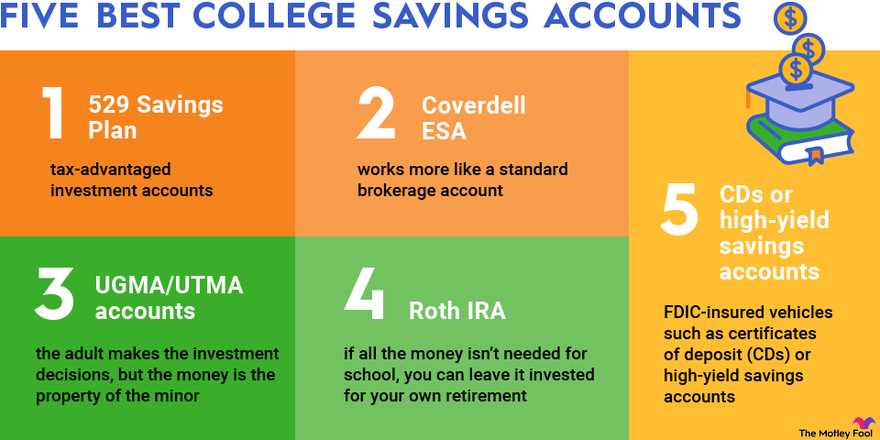Saving for a child's education requires some important financial considerations, including whether to use a 529 plan or a Coverdell Education Savings Account (ESA). There are, of course, pros and cons to each tax-advantaged savings plan.
Savings Account
But like all things in personal finance, the decision will come down to each family's individual circumstances. This article will present you with enough details to make an informed decision about the best way to save for your child's education.

Key Takeaways
- The tax benefits of contributing to a 529 plan versus a Coverdell ESA differ.
- Each account type has a specific contribution limit.
- Qualified expenses can help you avoid penalties.
- There are pros and cons associated with each education savings account type -- below, you'll find a side-by-side comparison.
529 plans
529 plans
Anyone can open a 529 account for the benefit of a child, a grandchild, themselves, or anyone whose education they want to help fund. The big benefits of 529 plans are the potential tax savings on contributions, tax-free investment growth, and tax-free withdrawals for qualifying education expenses. They also have very high contribution limits and can be very flexible.
Although 529 plans are established under the federal tax code, it's actually the states that administer those plans. The structure of each state plan is similar, but there are differences in fees and the investment options available. While you can move your 529 account to a different state's plan after opening it, be sure to review all your options before picking one.
Some states will provide a tax deduction for contributing to a 529 plan. The limits on how much of your contribution is eligible for a deduction vary from state to state. Some states also require you to contribute to the state-sponsored 529 plan, while others will let you contribute to any plan you choose.
While 529 plans technically have contribution limits, most savers won't need to worry about them. Each state plan has a lifetime contribution limit per beneficiary, which ranges from $235,000 to $529,000.
People wanting to save more can open a 529 plan in another state for the same beneficiary. Those who save that much in a 529 may be more concerned with bumping up against the gift tax exclusion, as 529 contributions count as gifts to the beneficiary.
There are two types of 529 plans: an education savings plan and a prepaid tuition plan.
529 education savings plans
An education savings plan allows the account holder to choose an investment, usually from a group of mutual funds. Many offer a set of target-date funds that will adjust the asset allocation in the account as your child nears college age. The dividends and gains on the investments in the account will not incur taxes. And withdrawals for qualified expenses won't incur any income tax either.
Qualified expenses include tuition, fees, room and board, and other related costs for college. Additionally, 529 account holders can withdraw as much as $10,000 per year for K-12 tuition. Funds can also be withdrawn to pay off as much as $10,000 in student loans (per lifetime).
Starting in 2024, beneficiaries can roll over as much as $35,000 in funds from a 529 to a Roth IRA after the account has been established for 15 years. This provides an escape hatch for overfunded accounts, encouraging more families to use a 529 account to help save for college.
529 prepaid tuition plans
Some states offer prepaid tuition plans for college and university. The idea is to allow a family to lock in the current tuition rates for a child well before they actually go off to college. Considering how quickly the cost of college is rising, this may be an appealing option for some.
There are some drawbacks, though. The funds only cover college tuition. There also may be restrictions on which colleges or universities the plan covers.
Coverdell ESAs
Coverdell ESAs
A Coverdell ESA is like a Roth IRA for education expenses. The biggest benefits of a Coverdell ESA are its extremely low fees, tax-free withdrawals on qualified expenses, and the ability to choose any investment your brokerage offers (e.g., stocks, bonds, exchange-traded funds (ETFs), options). The breadth of qualified expenses is also wider than those for 529 plans.
The big drawback of a Coverdell is the contribution limit. Anyone can contribute as much as $2,000 per year per beneficiary across all Coverdell plans. There's no tax deduction for the contributions, and contributions are limited if your adjusted gross income exceeds a certain threshold. You have until tax day of the following year to make a contribution for the previous year.
Another important factor is that all Coverdell ESA funds must be withdrawn when the beneficiary reaches 30 years old. You can change the beneficiary on the account to a younger family member, like a sibling or step-sibling, once per year, which can help avoid withdrawals. If a withdrawal is made for an unqualified expense, you'll owe taxes on the gains in the account, plus a 10% penalty.
Qualified expenses for a Coverdell ESA include a wide variety of education-related expenses for kindergarten through college. You can use the funds to pay for tuition, books, supplies, uniforms, room and board, tutoring, equipment, or even internet access.
What's the difference?
529 plan versus Coverdell ESA: What's the difference?
While the goal for saving in a 529 plan or a Coverdell ESA is the same, you should be aware of some important differences. The following table summarizes the biggest factors you should consider when making your choice.
| Factors to Consider | 529 Plan | Coverdell ESA |
|---|---|---|
| Contribution limit | No annual limit; each plan is subject to its own lifetime limit. | $2,000 per year maximum. |
| Income eligibility limits | None. | Full contribution for joint filers with an AGI of less than $190,000. Reduced for an AGI between $190,000 and $220,000. Ineligible above $220,000. |
| Investment options | Limited to options selected by the plan administrator. | Very limited restrictions. Invest in anything your broker offers. |
| Tax savings | Possible state tax deduction on contributions. Tax-free growth. Tax-free withdrawals for qualified expenses. | Tax-free growth. Tax-free withdrawals for qualified expenses. |
| Qualified expenses | College tuition, fees, room and board, and related expenses. As much as $10,000 per year in K-12 tuition. As much as $10,000 per lifetime in student loan payments. | Tuition, fees, room and board, tutoring, equipment, books, and related expenses for kindergarten through college. |
| Withdrawal deadline | None. | When the beneficiary reaches age 30. |
| Impact on financial aid | As much as 5.64% of account value above asset protection allowance. | As much as 5.64% of account value above asset protection allowance. |
| Fees | Management and administration fees, plus mutual fund expense ratios. | No to low fees. |
| Penalties | Income tax + 10% penalty on gains for unqualified distributions. | Income tax + 10% penalty on gains for unqualified distributions. |
Which is right for you?
Everyone's situation is different. But a few factors could sway your decision on a 529 plan versus a Coverdell ESA.
If you live in a state that offers a tax deduction for 529 contributions or you make more than the income limits for a Coverdell contribution, the 529 plan is likely for you. If you expect to use the funds for expenses that don't qualify under a 529, use a Coverdell. The 529 plan offers some extra security for those fearing they may overfund education savings accounts.
First, there's no time limit on when you must withdraw funds. Second, you can use the funds to pay off $10,000 in student loans. And finally, you'll be able to roll the funds into a Roth IRA starting in 2024. That may give families more assurance that they won't get hit with undue tax penalties just to ensure their child has enough money to pay for school.
Related investing topics
Importantly, there's nothing saying you can't use both. If you want to use a Coverdell to help pay for education expenses while your children are in primary and secondary schools and a 529 to cover college expenses, you absolutely can.
529 Plan vs. Coverdell ESA: FAQs
Why choose a Coverdell over a 529?
There are three main reasons to choose a Coverdell over a 529. First, you can use the funds to pay for a wider range of education-related expenses. Second, the fees are lower (nonexistent) compared to a 529 plan. Third, there are very few restrictions on your investment choices in a Coverdell, while 529 plans are typically limited to select mutual funds.
What are the disadvantages of the Coverdell?
There are three primary disadvantages of the Coverdell Education Savings Account. First, the contribution limit is just $2,000 per year per beneficiary. Second, you must withdraw all funds from the account by the time the beneficiary reaches age 30, possibly incurring income tax and penalties on unqualified distributions. Third, you must have an adjusted gross income below a certain threshold to contribute, which could prevent you from contributing every year.
Should I withdraw from a Coverdell or a 529 first?
While everyone's situation is different, withdrawing first from a Coverdell will be the best option for most. The Coverdell requires that you withdraw all funds before the beneficiary reaches age 30. What's more, Coverdell ESAs have more utility than 529 accounts for students in grades K-12. The 529 funds can be used later in life to help pay student loans or rolled into a Roth IRA.
What is the primary difference between a Coverdell ESA and a 529 savings plan?
The primary difference between a Coverdell ESA and a 529 savings plan is the expenses that qualify for tax-free withdrawals. A Coverdell allows for a wider range of education-related expenses, especially pertaining to K-12 students. A 529 allows beneficiaries to pay off as much as $10,000 in student loans.









